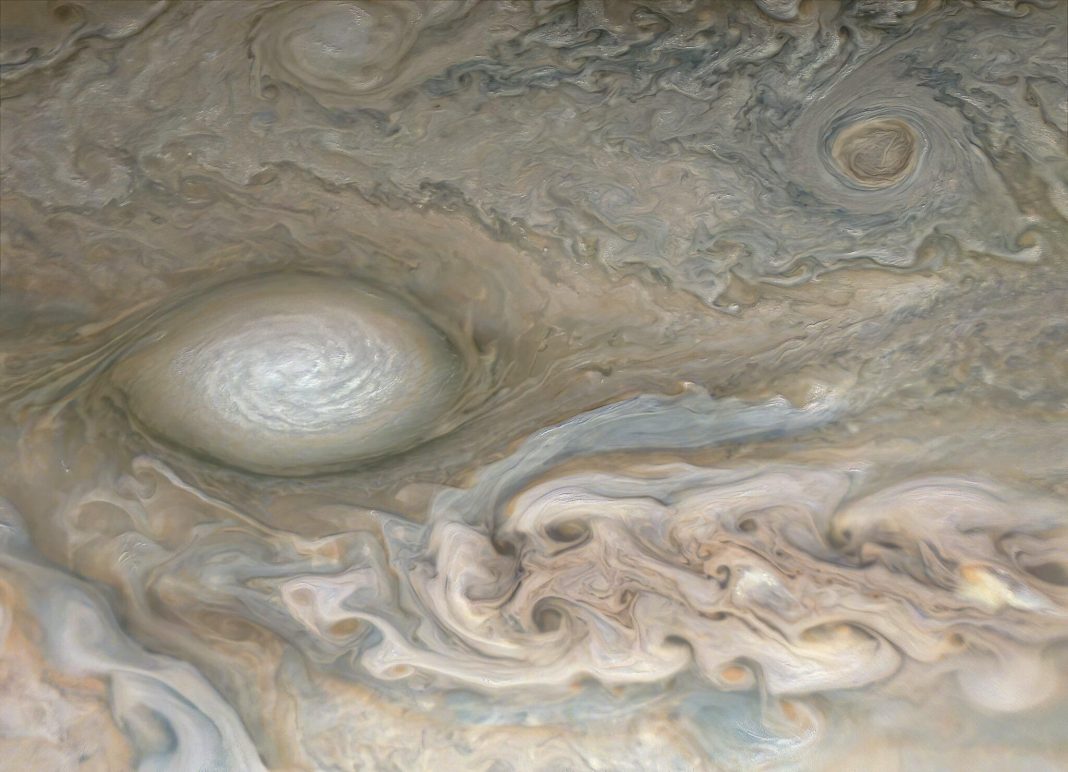
The large white oval and jet stream in the northern latitudes of Jupiter, taken by NASA’s Juno … [+]
NASA/JPL-Caltech/SwRI/MSSS/Kevin M. Gill
NASA’s Juno spacecraft has sent back yet another batch of astonishing new images from Jupiter—and some unique images of its moon Ganymede have also emerged.
These new images from its 28th flyby come as the solar-powered spacecraft celebrates four years in orbit around the gas giant planet, which has just come to opposition for us on Earth, along with fellow giant planet Saturn.

Jupiter as a crescent as Juno approached it at the weekend.
NASA/JPL-Caltech/SwRI/MSSS/Kevin M. Gill
At Jupiter since July 5, 2016, Juno has been in an elliptical polar orbit that has it spend most of its time away from the planet.
Only every 53 days does it get close to Jupiter, but during its brief flyby it gets super-close to the planet’s cloud-tops to take some astonishing photos.
Each dip close to Jupiter is called a perijove, which is Greek for the extreme points in the orbit of one body around another.
It’s in the few days after each perijove that Juno sends back its images via NASA’s Deep Space Network.
However, NASA isn’t actually responsible for most of the images we see coming from Juno at Jupiter; raw imagers from JunoCam are uploaded after each perijove and very soon freely available for “citizen scientists” to download and post-process into wonderful photos.

Detail on Jupiter from Juno’s perijove 28 flyby on July 28, 2020.
NASA/JPL-Caltech/SwRI/MSSS/Kevin M. Gill
“Juno’s images have taught us so much about the dynamic nature of Jupiter’s atmosphere in a level of detail that we haven’t ever seen before, especially when correlated with data from the infrared imager, magnetometer data, and with Earth-bound observations,” said Kevin M. Gill, a software engineer at NASA-JPL, to me via email. Gill is one of the hardest working “citizen scientists” on the JunoCam. “Most of the work is done when I’m on lunch, a break, or after hours,” he said.

Jupiter as captured by Juno on July 28, 2020.
NASA/JPL-CALTECH/SWRI/MSSS/KEVIN M. GILL
The public availability of Juno’s raw images have resulted in some incredible images including Jupiter’s “racing stripes,” its giant jet-stream, a classic “Jupiter Marble” portrait, and a “churning” Jupiter.
If you want to see more see Gill’s Twitter account and check-out the “featured submissions” page on the mission’s outreach website.

Jupiter’s southern circumpolar cyclones, processed by citizen scientist Svetoslav Alexandrov.
NASA / JPL-Caltech / SwRI / MSSS / Svetoslav Alexandrov © CC BY
Its unusual orbit enables it to take valuable scientific observations, though arguably it’s the wondrous images it sends back that have made it one of the most popular NASA missions yet.
The spacecraft’s JunoCam shoots images as it spins using its basic two-megapixel, 58° field of view camera.

The first infrared images of Ganymede’s northern frontier, taken by NASA’s Juno spacecraft took on … [+]
NASA/JPL-Caltech/SwRI/ASI/INAF/JIRAM
Although Juno hasn’t been able to study many of Jupiter’s 79 moons, NASA last week published images the probe managed to snap of its giant moon Ganymede. Bigger than the planet Mercury, Ganymede consists primarily of water ice and is the only moon in the solar system with its own magnetic field.
The images—taken using Juno’s Jovian Infrared Auroral Mapper (JIRAM) instrument on December 26, 2019, but only published now—are the first infrared images of the moon’s north pole.

The north pole of Ganymede can be seen in center of this annotated image taken by the JIRAM infrared … [+]
NASA/JPL-Caltech/SwRI/ASI/INAF/JIRAM
Juno’s JIRAM was designed to capture the infrared light emerging from deep inside Jupiter, probing its weather down to 30 to 45 miles (50 to 70 kilometers) below Jupiter’s cloud tops. However, the instrument can also be used to study the moons Io, Europa, Ganymede, and Callisto.
Juno got to within 62,000 miles/100,000 kilometers of Ganymede and collected 300 infrared images of its surface.
Here’s a wonderful time-lapse video from Gill that compiles images taken by JunoCam during June’s perijove 27 flyby of Jupiter:
he NASA spacecraft’s scientific mission is to study Jupiter’s atmosphere and magnetosphere. It spends most of its time away from Jupiter taking measurements of the outer atmosphere and magnetosphere.
Juno is part of NASA’s New Frontiers missions. It launched on August 5, 2011, on an Atlas V rocket, reached Jupiter in July 2016.

A fun, false-colorized Jupiter from a previous flyby, edited using Photoshop, created by citizen … [+]
NASA/JPL-Caltech/SwRI/MSSS/Gerald Eichstädt/Seán Doran/Rachel Tortorici © CC BY
Juno will complete its mission on July 30, 2021. While on its 35th and final perijove it will be purposely crashed into Jupiter’s atmosphere, where it will disintegrate.
However, Juno’s scientific discoveries will pave the way for the European Space Agency’s JUpiter ICy moons Explorer (JUICE) mission, which from 2030 will spend over three years exploring Jupiter’s giant magnetosphere, turbulent atmosphere, and its moons Ganymede, Callisto and Europa.

Another view of Jupiter from Juno, taken earlier this week.
NASA/JPL-Caltech/SwRI/MSSS/Kevin M. Gill
So what’s most exciting to Juno’s citizen scientists? “In addition to the obvious current choice, NASA’s Perseverance Rover, I’m very excited about the Europa Clipper mission and the Dragonfly mission to Titan,” said Gill. “All will be returning spectacular and unprecedented imagery of their respective targets.”
Wishing you clear skies and wide eyes.









